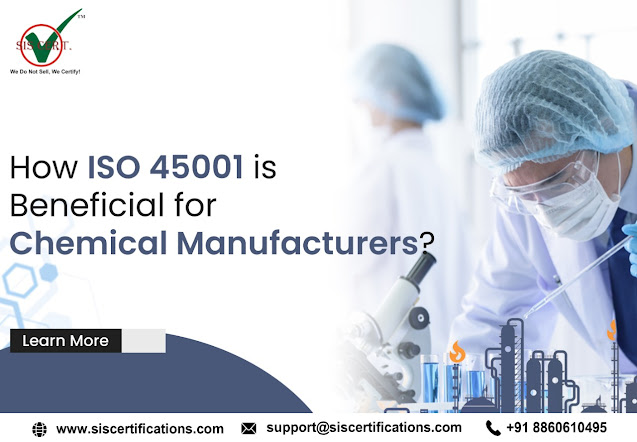How ISO 45001 is beneficial for chemical manufacturers?
The chemical industry is acknowledged as one of the most potent sources of environmental pollution. These industries are a possible threat to the safety of the workers, with irreversible consequences. Therefore, International Organization for Standardization (ISO) has published a standard as per ISO 45001 Certification for establishing and maintaining Occupational Health and Safety Management system in the organization. This standard is one of the prime components for ensuring the occupational health and safety of the employees in your organization.
Important elements for implementing ISO 45001 Certification in the chemical industry?
1. The Requirements of ISO 45001 Certification:
The High-level Structure of ISO 45001
revolves around the principle of Plan-Do-Check-Act. The Annex- SL consists of
10 sections, out of which the first three are introductory in nature while the
rest seven are auditable and give the requirements for the implementation of
ISO 45001 Certification for OHSMS.
Let’s understand the last seven
sections for ISO 45001 standard in detail:
• SECTION 4-
Context of the organization:
This section deals with the scope of
OHSMS in your business organization and understanding the needs of the
interested parties. It deals with understanding the requirements of your
organization such as review of documents, reports, etc. for implementing the
occupational health & safety management systems.
• SECTION 4-
Context of the organization:
This section deals with the scope of
OHSMS in your business organization and understanding the needs of the
interested parties. It deals with understanding the requirements of your
organization such as review of documents, reports, etc. for implementing the
occupational health & safety management systems.
• SECTION 6-
Planning:
This includes planning the objectives
for your current management system and analyses the risks involved, in order to
eliminate those risks. It also involves analyzing the organizational processes
for a healthy and safe management system.
SECTION 7-
Support:
This section includes all the
resources, such as human resources, infrastructure, and others that are
required for an effective occupational health and safety management system.
This section demonstrates the requirements as per the standard around
competence, awareness, maintenance, and controlling documented data.
SECTION 8-
Operation:
This section deals with operational
requirements for the proper health and safety management system. It involves
determining the requirements for educational products and services as well as
establishing control processes for the implementation of the Occupational
Health & Safety Management System.
SECTION 9-
Performance evaluation:
This section involves monitoring and
measurement of the progress of OHSMS in terms of worker satisfaction. The
organization is needed to analyze and evaluate the information and conduct an
internal audit as well as a management review.
SECTION 10-
Improvement:
This section ensures that your occupational health & safety management system is effective. It deals with the methods by which you can ensure the effective and efficient functioning of your management system.
2. Hazards that are likely to occur in the chemical industry:
There are various risks that are involved in the chemical industries, which can result in serious trouble for the workers in the organization. Let us look at these potential hazards:
- Hazard based on equipment: Generally, chemical processing industries utilize lots of equipment for proper functioning. This equipment includes- hydraulic, electrical, and pneumatic or a combination of all elements. Appropriate training along with a timely service system will help the workers to use the equipment correctly, which in return will help your organization minimize the chances of risks related to the equipment.
- Hazards related to fumes/liquids: Chemical processing industry, primarily involves hazardous liquids and poisonous fumes that can be a threat to the health and safety of the employees working there. Proper knowledge should be provided to the worker in order to prevent the risks of health and safety.
Various challenging factors are found in the chemical-based industry. Recognizing
all the hazard-specific to the chemical industry is central to the overall
performance of the ISO 45001 standard for OHSMS. Using all the strategic
measures and procedures in order to prevent the potential risks of hazards, it
becomes easier to implement ISO 45001 Certification Saudi Arabia in
organizations.
Some measures that can help to prevent or mitigate hazardous situations
from the organization that deals with Chemicals are as follows:
• Fulfilment of the requirement
as per ISO 45001 standard.
• Continuous feedback from the
employees and suggestions on board.
• Establish an OHSMS that belongs to all the workers of the organization.
With proper
execution of the above-mentioned key points, you can see positive results that
will be reflected in your organization.




Very nice information...
ReplyDeleteISO 22301 Lead Auditor Course
Amazing details given. Thanks for sharing such a great blog Keep posting..
ReplyDeleteiso 22000 adalah